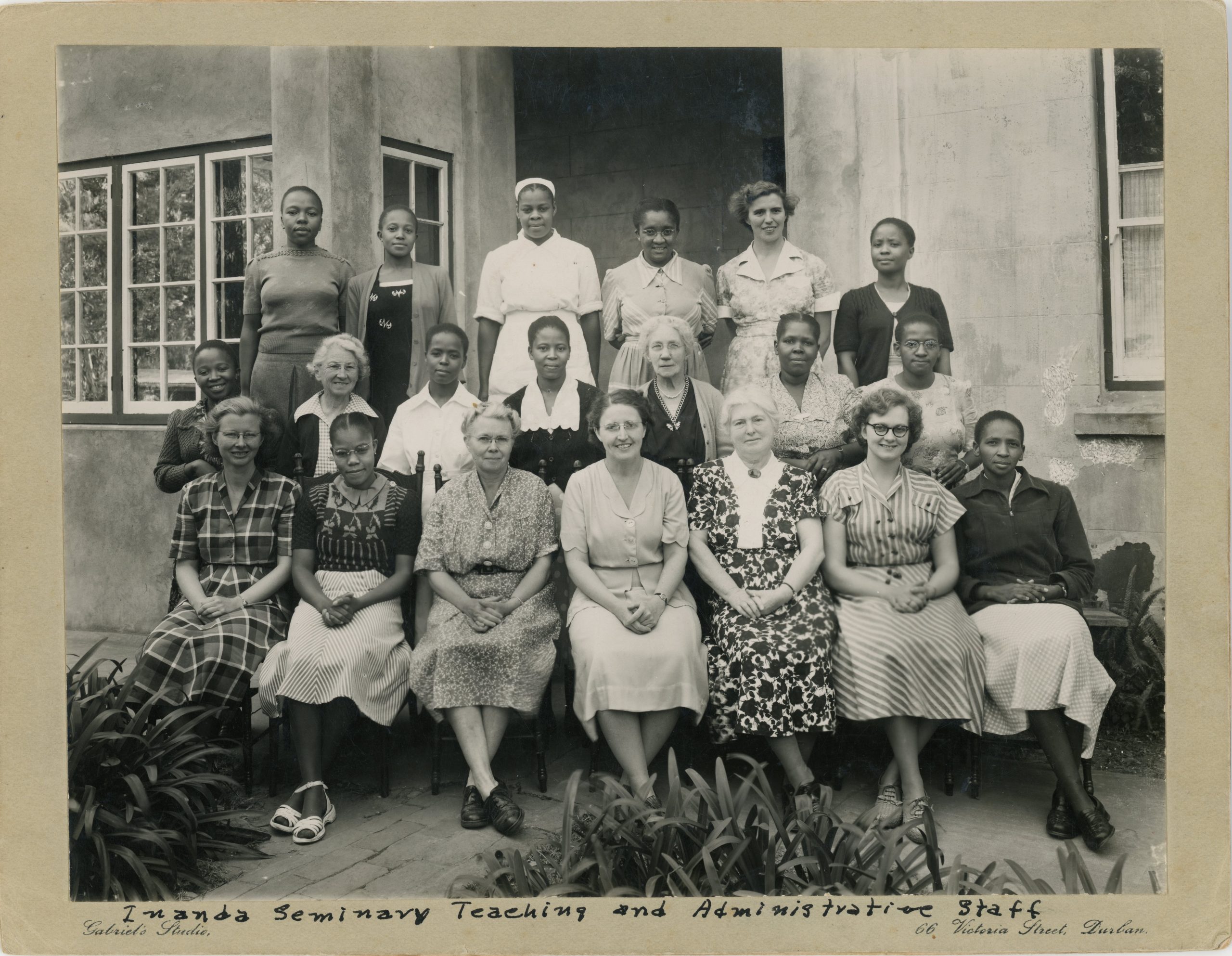Welcome to a new blog series detailing my work processing the Lavinia Scott papers, one of our newly acquired collections. I’m Meghan Glasbrenner, Assistant Processing Archivist for SCRC, and I am excited to introduce you all to Lavinia Scott, aunt of former George Mason University Provost (2000-2014) and Professor of History Dr. Peter Stearns.

Lavinia Scott as a young woman in Illinois

Lavinia Scott in American Board Mission portrait
Born Clara Lavinia Scott in Yankton, South Dakota in 1907 to George Harvey and Mary Maud Cole Scott, Lavinia, as she was exclusively known and referred to throughout both her personal and professional life, was the youngest of four children (siblings William, Franklin, and [Mary] Elizabeth). Having spent most of her formative years in and around Illinois College, where her father worked as a professor until his sudden death in 1926, and where she graduated from the following year, it was no surprise that Lavinia would devote her life to education. However, what was more surprising to her family was her choice to combine this passion for teaching with a calling to international missionary work.

Principal Lavinia Scott (seated front center) with the teaching and administrative staff of Inanda Seminary, late 1950s
After two years of training work with the United Congregational Church (UCC), in 1932 she was assigned as an educational missionary to South Africa by the American Board of Commissioners for Foreign Missions. Altogether, Lavinia would spend the next 40 years working and teaching at three different mission schools in South Africa: teacher at Adams College (1932-1936), Principal of Inanda Seminary (1936-1969), and teacher at Federal Theological Seminary (1969-1974). Additionally, during these years she completed a Master of Arts degree program with the Yale Divinity School, studied the Zulu language, and in 1954 was awarded an honorary Doctor of Humane Letters degree by Illinois College.

Title page of a full bound copy of Lavinia Scott’s master’s thesis, reflecting her dedication to the culture and people of South Africa
Throughout her time in South Africa, and extending into her retirement, Lavinia was also a vocal critic of the government’s discriminatory Apartheid policies, particularly the Bantu Education Act of 1953, which significantly lowered the quality of the education available to Black South Africans, including removing any government funding from private missionary schools. As a result, many of these non-government sanctioned schools were forced to close down…but not Inanda Seminary. This is owed in large part to Lavinia’s strong dedication to the school’s mission and fierce activism on behalf of the community she had dedicated her life to serving.

The collection includes extensive correspondence and reports detailing the successful campaign to maintain the operational status of Inanda Seminary, such as the above form letter sent to local congregations asking for contributions
This vigor with which she fought the restrictive regulations of the Bantu Education Act continued well after she retired to Claremont, CA in 1974, maintaining an active role in international causes, including on behalf of those she left behind in South Africa (maintaining constant contact with the administration of Inanda Seminary) and United States policy in Central America, as well as domestic civil rights issues.

The above letter, sent to the US Attorney General regarding the response and verdict to the Rodney King trial in 1992, is just one example of the numerous letters to state and federal officials included in the collection, detailing Lavinia’s lifelong devotion to civil and human rights
While formal processing is still in its early stages, my initial survey of the Lavinia Scott papers, which consists of approximately 15 linear feet of materials, reveals a wide mix of items collected over the course of her lifetime, including correspondence, photographs, historical documents and reports, and various artifacts. These items reflect her professional accomplishments and together present a picture of a woman with a lifelong passion for learning, not only from books (although she certainly had a lot), but from the many and varied people and cultures that she encountered.

Clara Lavinia Scott passed away on July 10, 1997 at the age of 90. She is buried in Diamond Grove Cemetery in Jacksonville, IL along her parents and her older brothers William and Franklin
Over the course of this series, I’ll be chronicling some of the questions that occur during processing of a collection of this nature and highlighting some of its more unexpected stories, such as graduates of Inanda Seminary (Lavinia maintained extensive contact with many of her “Inanda girls”) and items such as picture postcards and travel maps from a number of domestic and international destinations ranging from London, England to the great South Dakota Corn Palace – a personal papers collection is so much more than a biography!
The first question I’ll be tackling is how to create “archival” order in the absence of “original” order. In other words, when presented with a collection that does not reflect any specific original arrangement by the creator (aka Lavinia Scott) what is the most useful order that can be created to best help future use and understanding of the collection?
Follow SCRC on Social Media and look out for future posts on our Facebook, Instagram, and Twitter accounts. To search the collections held at Special Collections Research Center, go to our website and browse the finding aids by subject or title. You may also e-mail us at speccoll@gmu.edu or call 703-993-2220 if you would like to schedule an appointment, request materials, or if you have questions.

